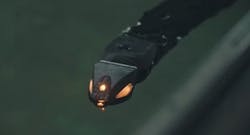If you read my earlier post about the dearth of automation companies at one of the oil and gas industry’s largest events, you're probably wondering how I could write an article so soon afterward about a cutting edge automation advance being made by a company focused on oil and gas. But this is one example that really stood out at the event as being innovative not just for the oil and gas industry, but for industrial technology in general.
The Eelume (pronounced ee-loom) robot is a snake-like robot designed for inspection, maintenance and repair of undersea oil and gas operations. It is essentially a maneuverable robot arm with onboard propulsion so that it can swim on its own and not require connection to a remotely operated vehicle (ROV), as such subsea robot arms typically require. See the video of the Eelume robot below.
Driving development of the Eelume robot are the high costs associated with undersea oil and gas inspection, maintenance and repair via ROVs operated by surface vessels. Two factors driving up these costs are the aging of existing subsea oil and gas operations that require a high level of maintenance and repair and the increasing depth at which new subsea installations are often located. According to Eelume, subsea maintenance costs have tripled since 2005 as a result of these two factors.
Due to its autonomous abilities, the Eelume robot stays at the subsea site and is used as needed for inspection, maintenance or repairs.
Key partners working with Eelume on the development of the robot include: Statoil, which provides the subsea facilities on which to test the robot; Kongsberg Maritime which has more than two decades of subsea robotic technology experience; and the Norwegian University of Science and Technology (NTNU).
Since the robot is still in development, not many details surrounding the robot’s automation technologies have yet been made public. However, Asgeir Sorenson, professor of marine control systems and director of autonomous marine operations & systems at NTNU, said at ONS 2016 that demand is so high for this technology that he expects a commercial version to be available in the next two years.
Eelume Robot Video
Leaders relevant to this article:


